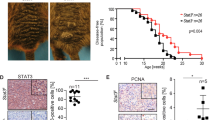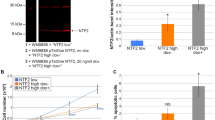Abstract
The canonical Wnt signalling pathway induces the β-catenin/lymphoid enhancer factor transcription factors. It is activated in various cancers, most characteristically carcinomas, in which it promotes metastatic spread by increasing migration and/or invasion. The Wnt/β-catenin signalling pathway is frequently activated in melanoma, but the presence of β-catenin in the nucleus does not seem to be a sign of aggressiveness in these tumours. We found that, unlike its positive role in stimulating migration and invasion of carcinoma cells, β-catenin signalling decreased the migration of melanocytes and melanoma cell lines. In vivo, β-catenin signalling in melanoblasts reduced the migration of these cells, causing a white belly-spot phenotype. The inhibition by β-catenin of migration was dependent on MITF-M, a key transcription factor of the melanocyte lineage, and CSK, an Src-inhibitor. Despite reducing migration, β-catenin signalling promoted lung metastasis in the NRAS-driven melanoma murine model. Thus, β-catenin may have conflicting roles in the metastatic spread of melanoma, repressing migration while promoting metastasis. These results highlight that metastasis formation requires a series of successful cellular processes, any one of which may not be optimally efficient.
This is a preview of subscription content, access via your institution
Access options
Subscribe to this journal
Receive 50 print issues and online access
$259.00 per year
only $5.18 per issue
Buy this article
- Purchase on Springer Link
- Instant access to full article PDF
Prices may be subject to local taxes which are calculated during checkout







Similar content being viewed by others
References
Lugli A, Zlobec I, Minoo P, Baker K, Tornillo L, Terracciano L et al. Prognostic significance of the wnt signalling pathway molecules APC, beta-catenin and E-cadherin in colorectal cancer: a tissue microarray-based analysis. Histopathology 2007; 50: 453–464.
Baldus SE, Monig SP, Huxel S, Landsberg S, Hanisch FG, Engelmann K et al. MUC1 and nuclear beta-catenin are coexpressed at the invasion front of colorectal carcinomas and are both correlated with tumor prognosis. Clin Cancer Res 2004; 10: 2790–2796.
Bachmann IM, Straume O, Puntervoll HE, Kalvenes MB, Akslen LA . Importance of P-cadherin, beta-catenin, and Wnt5a/frizzled for progression of melanocytic tumors and prognosis in cutaneous melanoma. Clin Cancer Res 2005; 11 (24 Pt 1): 8606–8614.
Chien AJ, Moore EC, Lonsdorf AS, Kulikauskas RM, Rothberg BG, Berger AJ et al. Activated Wnt/beta-catenin signaling in melanoma is associated with decreased proliferation in patient tumors and a murine melanoma model. Proc Natl Acad Sci USA 2009; 106: 1193–1198.
Larue L, Beermann F . Cutaneous melanoma in genetically modified animals Pigment. Cell Res 2007; 20: 485–497.
Luciani F, Champeval D, Herbette A, Denat L, Aylaj B, Martinozzi S et al. Biological and mathematical modeling of melanocyte development. Development 2011; 138: 3943–3954.
Delmas V, Beermann F, Martinozzi S, Carreira S, Ackermann J, Kumasaka M et al. Beta-catenin induces immortalization of melanocytes by suppressing p16INK4a expression and cooperates with N-Ras in melanoma development. Genes Dev 2007; 21: 2923–2935.
Haegel H, Larue L, Ohsugi M, Fedorov L, Herrenknecht K, Kemler R . Lack of beta-catenin affects mouse development at gastrulation. Development 1995; 121: 3529–3537.
Arozarena I, Bischof H, Gilby D, Belloni B, Dummer R, Wellbrock C . In melanoma, beta-catenin is a suppressor of invasion. Oncogene 2011; 30: 4531–4543.
Sinnberg T, Menzel M, Ewerth D, Sauer B, Schwarz M, Schaller M et al. Beta-catenin signaling increases during melanoma progression and promotes tumor cell survival and chemoresistance. PLoS One 2011; 6: e23429.
Eichhoff OM, Weeraratna A, Zipser MC, Denat L, Widmer DS, Xu M et al. Differential LEF1 and TCF4 expression is involved in melanoma cell phenotype switching. Pigment Cell Melanoma Res 2011; 24: 631–642.
Carreira S, Goodall J, Denat L, Rodriguez M, Nuciforo P, Hoek KS et al. Mitf regulation of Dia1 controls melanoma proliferation and invasiveness. Genes Dev 2006; 20: 3426–3439.
Larue L, Delmas V . The WNT/Beta-catenin pathway in melanoma. Front Biosci 2006; 11: 733–742.
de Melker AA, Desban N, Duband JL . Cellular localization and signaling activity of beta-catenin in migrating neural crest cells. Dev Dyn 2004; 230: 708–726.
Murakami T, Toda S, Fujimoto M, Ohtsuki M, Byers HR, Etoh T et al. Constitutive activation of Wnt/beta-catenin signaling pathway in migration-active melanoma cells: role of LEF-1 in melanoma with increased metastatic potential. Biochem Biophys Res Commun 2001; 288: 8–15.
Brooks SA, Lomax-Browne HJ, Carter TM, Kinch CE, Hall DM . Molecular interactions in cancer cell metastasis. Acta Histochem 2010; 112: 3–25.
Damsky WE, Curley DP, Santhanakrishnan M, Rosenbaum LE, Platt JT, Gould Rothberg BE et al. Beta-catenin signaling controls metastasis in Braf-activated Pten-deficient melanomas. Cancer Cell 2011; 20: 741–754.
Mackenzie MA, Jordan SA, Budd PS, Jackson IJ . Activation of the receptor tyrosine kinase Kit is required for the proliferation of melanoblasts in the mouse embryo. Dev Biol 1997; 192: 99–107.
Delmas V, Martinozzi S, Bourgeois Y, Holzenberger M, Larue L . Cre-mediated recombination in the skin melanocyte lineage. Genesis 2003; 36: 73–80.
Bottomly D, Kyler SL, McWeeney SK, Yochum GS . Identification of {beta}-catenin binding regions in colon cancer cells using ChIP-Seq. Nucleic Acids Res 2010; 38: 5735–5745.
Hoek KS, Schlegel NC, Brafford P, Sucker A, Ugurel S, Kumar R et al. Metastatic potential of melanomas defined by specific gene expression profiles with no BRAF signature. Pigment Cell Res 2006; 19: 290–302.
Guarino M . Src signaling in cancer invasion. J Cell Physiol 2010; 223: 14–26.
Ackermann J, Frutschi M, Kaloulis K, McKee T, Trumpp A, Beermann F . Metastasizing melanoma formation caused by expression of activated N-RasQ61K on an INK4a-deficient background. Cancer Res 2005; 65: 4005–4011.
Kielhorn E, Provost E, Olsen D, D’Aquila TG, Smith BL, Camp RL et al. Tissue microarray-based analysis shows phospho-beta-catenin expression in malignant melanoma is associated with poor outcome. Int J Cancer 2003; 103: 652–656.
Kageshita T, Hamby CV, Ishihara T, Matsumoto K, Saida T, Ono T . Loss of beta-catenin expression associated with disease progression in malignant melanoma. Br J Dermatol 2001; 145: 210–216.
Omholt K, Platz A, Ringborg U, Hansson J . Cytoplasmic and nuclear accumulation of beta-catenin is rarely caused by CTNNB1 exon 3 mutations in cutaneous malignant melanoma. Int J Cancer 2001; 92: 839–842.
Widlund HR, Horstmann MA, Price ER, Cui J, Lessnick SL, Wu M et al. Beta-catenin-induced melanoma growth requires the downstream target Microphthalmia-associated transcription factor. J Cell Biol 2002; 158: 1079–1087.
Schepsky A, Bruser K, Gunnarsson GJ, Goodall J, Hallsson JH, Goding CR et al. The microphthalmia-associated transcription factor Mitf interacts with beta-catenin to determine target gene expression. Mol Cell Biol 2006; 26: 8914–8927.
Bennett DC, Cooper PJ, Dexter TJ, Devlin LM, Heasman J, Nester B . Cloned mouse melanocyte lines carrying the germline mutations albino and brown: complementation in culture. Development 1989; 105: 379–385.
Gallagher SJ, Luciani F, Berlin I, Rambow F, Gros G, Champeval D et al. General strategy to analyse melanoma in mice. Pigment Cell Melanoma Res 2011; 24: 987–988.
Korinek V, Barker N, Morin PJ, van Wichen D, de Weger R, Kinzler KW et al. Constitutive transcriptional activation by a beta-catenin-Tcf complex in APC-/- colon carcinoma. Science 1997; 275: 1784–1787.
Larue L, Antos C, Butz S, Huber O, Delmas V, Dominis M et al. A role for cadherins in tissue formation. Development 1996; 122: 3185–3194.
Acknowledgements
We would like to thank D Bennett, M Herlyn and F Beermann for kindly providing materials. We thank staff from the animal colony and imaging facilities of Curie, including Y Bourgeois, F Cordelières and H Harmange in particular. SG was supported by LNCC and Curie. This work was supported by the Ligue Nationale Contre le Cancer (Equipe labellisée) and INCa.
Author information
Authors and Affiliations
Corresponding author
Ethics declarations
Competing interests
The authors declare no conflict of interest.
Additional information
Supplementary Information accompanies the paper on the Oncogene website
Supplementary information
Rights and permissions
About this article
Cite this article
Gallagher, S., Rambow, F., Kumasaka, M. et al. Beta-catenin inhibits melanocyte migration but induces melanoma metastasis. Oncogene 32, 2230–2238 (2013). https://doi.org/10.1038/onc.2012.229
Received:
Revised:
Accepted:
Published:
Issue Date:
DOI: https://doi.org/10.1038/onc.2012.229
Keywords
This article is cited by
-
Exploring the genomic resources and analysing the genetic diversity and population structure of Chinese indigenous rabbit breeds by RAD-seq
BMC Genomics (2021)
-
Coupling of melanocyte signaling and mechanics by caveolae is required for human skin pigmentation
Nature Communications (2020)
-
Tspan8-β-catenin positive feedback loop promotes melanoma invasion
Oncogene (2019)
-
Feeder Cells Free Rabbit Oral Mucosa Epithelial Cell Sheet Engineering
Tissue Engineering and Regenerative Medicine (2018)
-
CTNNB1-mutated melanocytic lesions with DPN like features: a distinct subtype of melanocytic tumors? A report of two cases
Virchows Archiv (2018)



